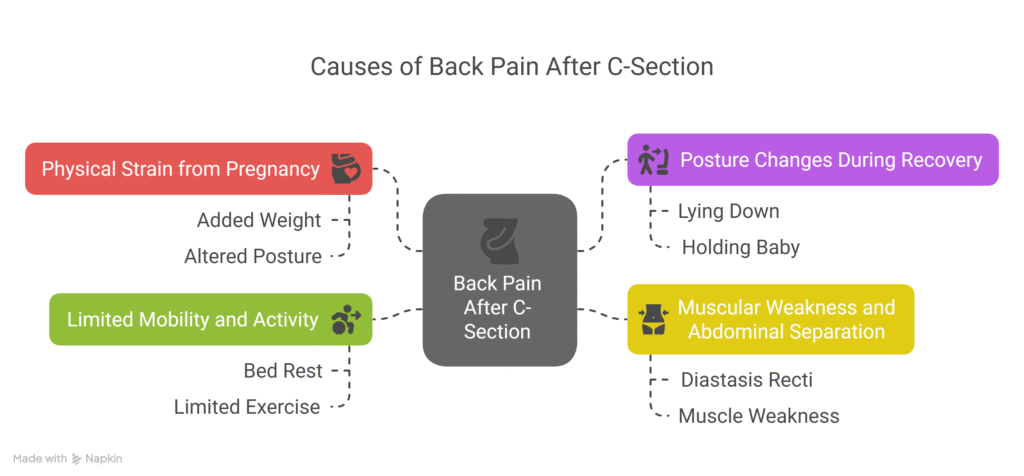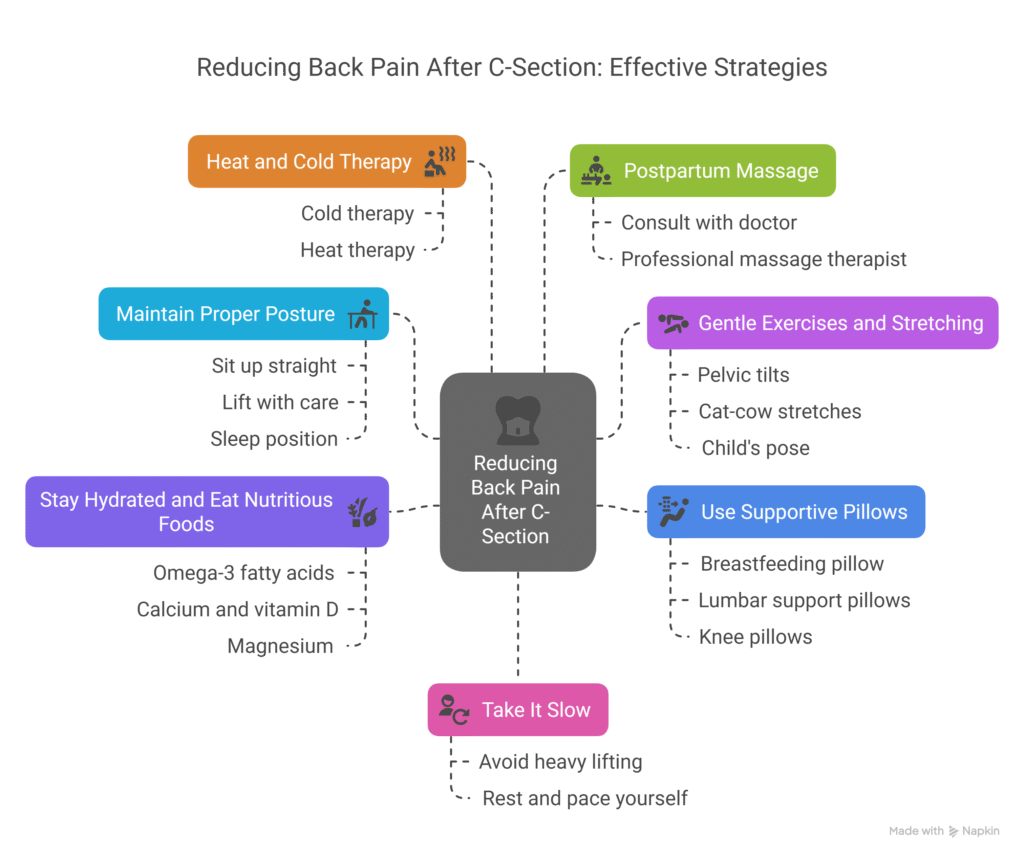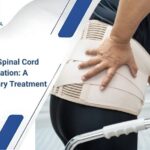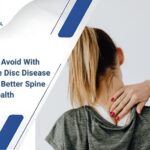How to Reduce Back Pain After C-Section :- Undergoing a C-section, or Cesarean delivery, is a significant procedure that requires recovery and self-care, both physically and emotionally. While the focus is often on healing the surgical site, many women experience back pain after C-section that can affect their ability to fully recover and enjoy their new life with their baby. If you’re wondering how to reduce back pain after C-section, this blog will provide insights into how to alleviate discomfort and improve your recovery process.
At Dr. Arun Saroha’s clinic, we understand the challenges new mothers face, especially when dealing with post-surgical pain. Whether the pain is a result of the surgery itself, the physical demands of caring for a newborn, or a combination of factors, we can offer helpful advice and strategies to make the recovery process smoother.
Why Does Back Pain Occur After C-Section?

Before we delve into how to reduce back pain after C-section, it’s important to understand the underlying causes of back pain after the procedure. The reasons can vary from person to person, but some common causes include:
1. Physical Strain from Pregnancy
During pregnancy, your body undergoes numerous changes to accommodate your growing baby. The added weight and altered posture can strain your back muscles and spine, which may cause discomfort even after delivery. These physical changes can take time to reverse, leaving you susceptible to back pain.
2. Posture Changes During Recovery
After a C-section, you are likely to adopt certain postures to protect your surgical site and avoid pain. You may spend a lot of time lying down or holding your baby in positions that put additional strain on your back. Poor posture during recovery can lead to tension in the muscles surrounding the spine, resulting in back pain.
3. Muscular Weakness and Abdominal Separation
C-sections involve cutting through the abdominal muscles, and during the recovery process, those muscles may not be as strong as they once were. This weakness can affect your overall posture and stability, putting extra strain on your lower back. Additionally, many women experience diastasis recti (separation of abdominal muscles) after pregnancy, which can contribute to back pain as your body tries to compensate for the lost support.
4. Limited Mobility and Activity
During the initial stages of recovery, many women find themselves restricted in their movement, especially with the need for bed rest or limited physical activity. The lack of movement and exercise can cause your back muscles to weaken, leading to stiffness and discomfort. How to reduce back pain after C-section involves not only addressing the specific pain but also restoring strength and flexibility through gradual activity.
How t o Reduce Back Pain After C-Section: Effective Tips

While it may take time for your body to fully recover from a C-section, there are several strategies that can help reduce back pain after C-section. Below are some effective tips to help you relieve discomfort and improve your overall well-being.
1. Maintain Proper Posture
One of the most important aspects of reducing back pain after C-section is adopting and maintaining proper posture throughout the day. Poor posture can exacerbate back pain and make it harder to heal from surgery. Here’s how to maintain good posture:
- Sit up straight: When sitting, keep your back straight and avoid slouching. Place a pillow behind your lower back for additional support.
- Lift with care: When lifting your baby or other objects, make sure to bend your knees and not your back. This will prevent undue stress on your spine.
- Sleep position: Sleeping on your side with a pillow between your knees can help maintain proper alignment and reduce back strain.
By being mindful of your posture throughout your daily activities, you can significantly reduce the strain on your back and minimize discomfort.
2. Gentle Exercises and Stretching
While you should avoid strenuous exercise during the early stages of recovery, gentle movements can help relieve tension in your back and improve circulation. How to reduce back pain after C-section can be achieved by incorporating light stretches and exercises into your daily routine. Some gentle exercises include:
- Pelvic tilts: Lie on your back with your knees bent and feet flat on the floor. Tighten your abdominal muscles and push your lower back into the floor, holding for a few seconds. Repeat 10-15 times.
- Cat-cow stretches: Start on your hands and knees. Slowly arch your back upwards and then lower it, lifting your head and tailbone. This motion will gently stretch your back muscles.
- Child’s pose: From a kneeling position, stretch your arms out and lower your chest towards the floor. This yoga pose helps stretch the lower back.
These simple exercises will help strengthen your core muscles and improve flexibility, which can reduce back pain over time.
3. Heat and Cold Therapy
Both heat and cold treatments can provide temporary relief from back pain. When used correctly, they can soothe sore muscles and reduce inflammation.
- Cold therapy: Applying an ice pack to the lower back for 15-20 minutes can help reduce inflammation and numb the area, especially if the pain is related to muscle strain or swelling.
- Heat therapy: Using a warm compress or heating pad on the lower back can help relax tight muscles and improve blood circulation. Be sure to use heat after the initial swelling has subsided.
Alternating between heat and cold can provide effective relief and help reduce the discomfort associated with back pain after C-section.
4. Use Supportive Pillows
After a C-section, you may spend a lot of time breastfeeding or holding your baby. Using supportive pillows can help reduce the strain on your back and make these activities more comfortable. Here are some tips:
- Breastfeeding pillow: Use a special breastfeeding pillow to support your baby at the right height, reducing strain on your back and neck.
- Lumbar support pillows: When sitting or lying down, consider using a pillow behind your lower back to maintain natural spinal alignment.
- Knee pillows: If you sleep on your side, placing a pillow between your knees can help keep your spine in proper alignment, reducing pressure on your lower back.
Proper support during rest and daily activities can help alleviate back pain after C-section and encourage healing.
5. Stay Hydrated and Eat Nutritious Foods
Proper nutrition plays a critical role in the recovery process. Staying hydrated and consuming a balanced diet with sufficient vitamins and minerals can help promote healing and reduce inflammation. Some foods that may aid in recovery and reduce back pain include:
- Omega-3 fatty acids: Found in fish like salmon, these healthy fats have anti-inflammatory properties.
- Calcium and vitamin D: These nutrients help maintain bone health and strength. Dairy products, leafy greens, and fortified foods are good sources.
- Magnesium: Found in nuts, seeds, and leafy vegetables, magnesium helps relax muscles and reduce muscle spasms.
Eating a nutritious diet and drinking plenty of water will support your body as it heals and can help reduce inflammation, which is a common cause of back pain.
6. Postpartum Massage
Massage therapy is a great way to relieve tension in your muscles and improve circulation. Postpartum massage can help reduce back pain after C-section by targeting areas of tightness and promoting relaxation. A professional massage therapist trained in postpartum care can help you find relief from the discomfort caused by muscle strain or tension.
Be sure to consult with your doctor before getting a massage, especially if you’ve had any complications during your C-section recovery.
7. Take It Slow
Recovering from a C-section takes time, and rushing the process can lead to more discomfort and even injury. It’s essential to take things slowly and give your body time to heal properly. Avoid heavy lifting or strenuous physical activity until your doctor clears you for more intense movements.
Even though it’s tempting to get back to your usual routine, resting and pacing yourself will help prevent strain on your back and promote healing.
When to Seek Medical Help
While these tips can help manage back pain after C-section, it’s important to consult your doctor if the pain persists or becomes severe. If you experience any of the following, it’s crucial to seek professional medical advice:
- Persistent or worsening pain despite following self-care methods.
- Pain that radiates to your legs or other areas of your body.
- Numbness or tingling sensations in your lower back or legs.
- Difficulty standing, walking, or moving.
Dr. Arun Saroha, a renowned spine surgeon, can assess your condition and recommend the best treatment plan tailored to your needs. Whether through physical therapy, medications, or advanced spinal treatments, seeking professional care can ensure that your recovery remains on track.
Discover Back Pain Relief After C-Section
Make An AppointmentConclusion
If you are wondering how to reduce back pain after C-section, the good news is that there are several natural methods you can use to ease your discomfort. By maintaining proper posture, incorporating gentle exercises, using heat and cold therapy, and supporting your body with nutritious food, you can significantly reduce back pain and promote healing.
However, always remember that recovery is a gradual process, and it’s important to listen to your body. If your back pain continues or worsens, don’t hesitate to consult with a professional like Dr. Arun Saroha, who can provide you with the expert care you need for a full recovery.










